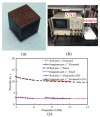3D-Printed Low-Cost Dielectric-Resonator-Based Ultra-Broadband Microwave Absorber Using Carbon-Loaded Acrylonitrile Butadiene Styrene Polymer
- PMID: 30036968
- PMCID: PMC6073229
- DOI: 10.3390/ma11071249
3D-Printed Low-Cost Dielectric-Resonator-Based Ultra-Broadband Microwave Absorber Using Carbon-Loaded Acrylonitrile Butadiene Styrene Polymer
Abstract
In this study, an ultra-broadband dielectric-resonator-based absorber for microwave absorption is numerically and experimentally investigated. The designed absorber is made of the carbon-loaded Acrylonitrile Butadiene Styrene (ABS) polymer and fabricated using the 3D printing technology based on fused deposition modeling with a quite low cost. Profiting from the fundamental dielectric resonator (DR) mode, the higher order DR mode and the grating mode of the dielectric resonator, the absorber shows an absorptivity higher than 90% over the whole ultra-broad operating band from 3.9 to 12 GHz. The relative bandwidth can reach over 100% and cover the whole C-band (4⁻8 GHz) and X-band (8⁻12 GHz). Utilizing the numerical simulation, we have discussed the working principle of the absorber in detail. What is more, the absorption performance under different incident angles is also simulated, and the results indicate that the absorber exhibits a high absorptivity at a wide angle of incidence. The advantages of low cost, ultra-broad operating band and a wide-angle feature make the absorber promising in the areas of microwave measurement, stealth technology and energy harvesting.
Keywords: 3D printing; Acrylonitrile Butadiene Styrene (ABS), ultra-broadband; Microwave absorption; dielectric resonator; periodical structure.
Conflict of interest statement
The authors declare no conflict of interest.
Figures






References
-
- Munk B.A. Frequency Selective Surfaces: Theory and Design. John Wiley & Sons; Hoboken, NJ, USA: 2005.
-
- Knott E.F., Schaeffer J.F., Tulley M.T. Radar Cross Section. SciTech Publishing; Stevenage, UK: 2004.
-
- Hemming L.H. Electromagnetic Anechoic Chambers: A Fundamental Design and Specification Guide. Wiley Interscience; Hoboken, NJ, USA: 2002.
-
- Wang B.X., Zhai X., Wang G.Z., Huang W.Q., Wang L.L. A novel dual-band terahertz metamaterial absorber for a sensor application. J. Appl. Phys. 2015;117:014504. doi: 10.1063/1.4905261. - DOI
LinkOut - more resources
Full Text Sources
Other Literature Sources

